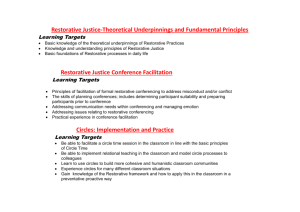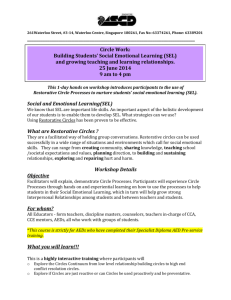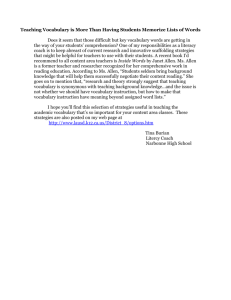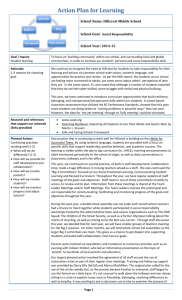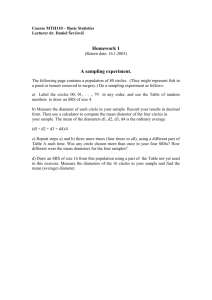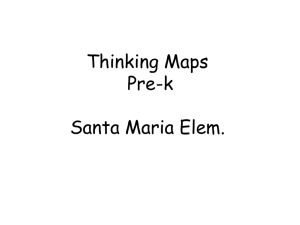Augustus Hawkins Site Visit Report
advertisement
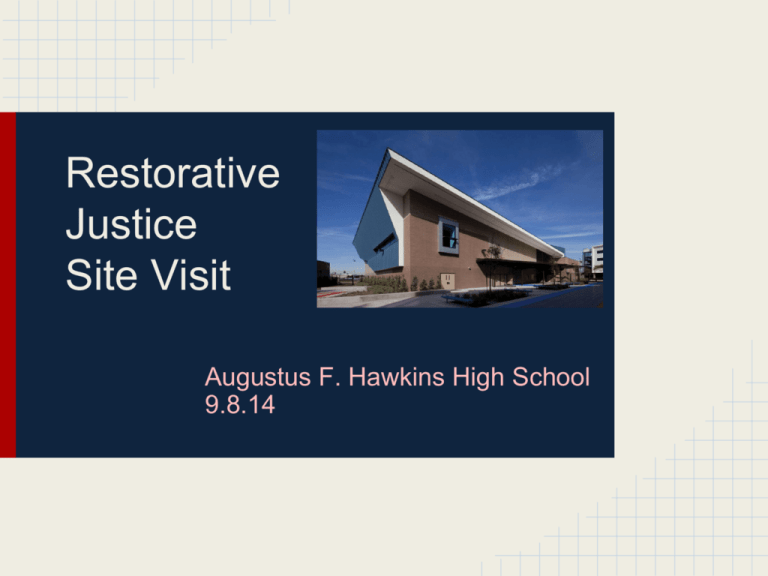
Restorative Justice Site Visit Augustus F. Hawkins High School 9.8.14 Overview On September 8, 2014, our team of Green Dot teachers and administrators interviewed students, teachers, and administrators at Hawkins High School in order to gather information and insight on the implementation of Restorative Justice at their site. We then compiled our findings into this report which include: I. What Augustus Hawkins stakeholders are saying about the implementation of Restorative Justice II. A Summary of Perspectives III. Our Recommendation for implementation Short History of Augustus F. Hawkins and RJ ● Augustus Hawkins High School opened in 2012 with the first graduating class in 2014. ● The school was named after Augustus Freeman (Gus) Hawkins, a Watts political leader and consists of three Small Learning Communities (CHAS, RISE, and CDAGS). ● Each Small Learning Community includes around 300-500 students and is overseen by a principal. Though SLC’s operate independently of each other, they work collaboratively. ● The Augustus Hawkins Pilot Plan included Restorative Justice as a foundation for the opening of the school. ● Augustus Hawkins High School is also known as the first school in South Los Angeles to use Restorative Justice. I. What Stakeholders are saying What Students are saying... Students say... “Before Joseph (Restorative Justice Coordinator) came it was all bad. There were fights in the classroom, students getting suspended and coming back with the same grudges. It’s not 100% better, but it’s getting there.” “When Ezell Ford died we had a circle about police brutality. We also have circles about incidents at our school and community. It feels good to know that our teachers actually care about our lives.” Students say... “We learn about different people, different ethnicities…It was really good. Before [I felt like] Latinos had something against Black people. When I went over there, they talked to us about that. There were white people, Latinos, Black people, Asian people, other races. You get to meet them. They make you understand that we’re all the same. It really helps out a lot.” Students say... Has Restorative Justice made you a better student? “Yes. I used to not do what I’m supposed to do. I used to not do my work. It really changed me because I realized school is not for friends.” “When I came back from [CCEJ] camp I started doing my work and I ended up with a 3.8.” Students say... To what degree would you recommend Restorative Justice for our school? How essential is RJ in a healthy school on a scale of 1 to 10? “10” “10” “10. It should be in every school” What Teachers are saying... Teachers say... How essential do you think RJ is for schools? “100% essential. Especially living in this community where our kids need to learn about a positive way or outlook about when we commit wrong or make mistakes, it gives us a chance. I’m a product of this community and just learning this is like WOW, we needed these years ago.” Teachers say... What impact did you see in school culture among students, staff, and in your classroom? “I think it’s been a positive impact especially with our students, the way they relate to each other, come to us, and say ‘I need a circle, this is happening…’ They already know that it’s a way to resolve problems. We need to prioritize that because then they won’t go out and solve it in their own way.” “For teachers that went to the training, it was 30 of us, it was just as positive as for the kids. The way we wait, reflect, and think before we respond to each other. We’re like kids as well; sometimes we’re quick to respond in a negative way, so it was an eye opener to be mindful of other adults on campus.” Teachers say... Do you feel the restorative justice training prepared you sufficiently? What further supports do you need? “We teachers need the circles as much as students. At my old site, we would get in circle every week. Because we modeled and practiced what we preached, that authenticity came out in the classroom…it was less uncomfortable to practice…we as educators need the benefits and those that aren’t comfortable need the practices and the scaffold.” What Administrators are saying... Administrators say…. “Expectation was clear, all teachers would do community building circles once a week in advisory. The grant (was) paid for a full time RJ coordinator who was available to sit in circles or pre-plan and go in and sit, or co-facilitate, or facilitate. ... If you need support, here’s the support.” “It’s really effective for fights, with both students in the circle together. I would say that 100% of our fights involved circles as part of the response. Whether we suspend or don’t suspend is up to the school and school culture. Every fight should have a circle.” Administrators say…. “So the next steps are to continue to build our capacity.” “The second big thing we need to do is create more accountability for when we do the circles for intervention…. our students feel the perception that RJ doesn’t hold students accountable… there has to be something explicit about the agreements that are reached and support in holding the students (and adults) and holding the community to those agreements.” Administrators say…. “Other infractions… Later in the year and into this year… we’re responding to more and more situations that fall short of fights that would lead to a fight, and it’s good for those situations. So many times, those students want to be heard.” “I’d say it’s been harder addressing drug related issues with circles. We’ve tried it, but it just shows how complex those situations are and how there’s probably a wide variety of responses.” Administrators say…. “Also, because of that we now use circles to respond schoolwide to trauma or other things that might happen. We had an incident with hate speech where something that a teacher had on her door was defamed, definitely hate speech, so a teacher developed a circle with an image and quote with an essential question for the circle and follow up, and a lot of teachers got htat PPT on Sunday and facilitated it on Monday. When you have that capacity, you as a school site can respond to variety of situations that you can respond to through that system. We didn’t do it so that if something bad happens on campus, you can do RJ. WE realized afterward that it was a way to respond to things school wide in advisory.“ II. Summary of Perspectives Student Perspective ● Strengths ● Process ● Other considerations Strengths Students said that Restorative Justice… ● ...changes students and their relationships with each other ● ...has helped to address racial barriers at the school ● … helps forge teacher-student relationships ● ...prepares students for leadership and life (see details of each strength in the full report) Process Students shared that: ● circles work best when students leave behind their ego and pride and just focus on listening to each other ● were honest and kept information confidential ● community circles take place weekly in advisory (harm circles occurred as needed) Process (continued) Students also shared that: ● any student or teacher can call a circle ● parents are often involved in harm circles ● Joseph (RJ coordinator) can help determine if a circle is needed or not ● Most circles are successful, but sometimes a student will come in determined not to let it work. “It’s all about the students’ mentality” Other Considerations Our conversation with the students revealed that: ● The Building Bridges camp was an essential component to learning the Restorative Justice framework / mindset ● The Restorative Justice Coordinator (Joseph) played a key role in facilitating RJ on all levels (eg. facilitating the most sensitive harm circles and determining if circles were necessary on a case by case basis) Teacher Perspective ● Strengths ● Process ● Other considerations Strengths Teachers said that Restorative Justice… ❖ created a better school culture, where teachers feel safer, more supported, and better prepared. ❖ promotes happier teachers, who are able to build relationships with students. ❖ improves discipline and behavior management in classes. ❖ teachers students a sense of self, where they are able to connect with teachers and self-advocate. Process Teachers explained the following as essential to the process: ❖ RJ training for teachers in the summer ❖ Circles done routinely in advisory across the entire school (once or twice a week) ❖ Harm circles by RJ coordinator, admin, or some teachers Other Considerations Teacher recommended & take-away’s from our team: ❖ Weekly or bi-monthly circles amongst staff are critical. ❖ An RJ coordinator or point-person is necessary for harm circles. ❖ Student leaders and student participation in CCEJ Camps. ❖ Providing RJ training for the entire staff. Administrator Perspective ● Strengths ● Process ● Other considerations Strengths ● School site leadership, in the form of the small school principal, firmly believe in Restorative Justice as an approach, not a program, that aids in establishing culture within the school, while providing structures for preventative and Response systems that help maintain a safe and civil community. ● The Principal points to examples of teachers that have taken the Restorative Justice approach and taken it to new levels as an instructional tool used to facilitate group structures within the classroom setting. ● Circles are also utilized to respond to school-wide trauma/harm. ● School leadership looks at the correlation between Restorative Justice and lower suspension numbers Process ● 2012-2013 - School founded with a Restorative Justice Approach.Teachers implemented community circles with varying levels of fidelity and effectiveness. ● 2013-2014 - School revisited their commitment and implementation of Restorative Justice. ● 2014-2015 - Administration focusing on solidifying their practices, to better leverage Restorative Justice as a behavior intervention. Our focus is on the 2013-2014 School Year Process: 2013-2014 School Year ● Hawkins wrote a grant for the California Endowment to better implement RJ. This led to the funding of a full time Restorative Justice Coordinator ● In the Summer of 2013, teachers attended a 3 day professional development around Restorative Justice, where they experienced and learned to run Community Circles. By the end of the 2013-2014 school year, 90% of staff members had attended the training. Process: 2013-2014 School Year ● As the school year began, teachers were expected to implement community building circles in their advisory classes at least once per week. ● Bell schedule was modified to include a longer advisory period on Fridays (60 minutes), for community circles ● During these circles, teachers pose 2-4 discussion questions which every student has the opportunity to respond to ● Staff would often collaborate to generate discussion questions based on events at their school, events in the world, and other topics of high-need and/or high-interest. ● The RJ coordinator was also available as a teacher support to help plan, participate, co-facilitate, or facilitate community cirlces. Process: 2013-2014 School Year ● Intervention and Harm Circles were also implemented in 2013-2014 year. ● Harm circles were used after fights (suspensions were given at discernment of administrator). ● Intervention circles were used after verbal altercations. Also used few larger-scale incidents (cyber bullying and gang intervention). Process: 2013-2014 School Year ● In the case of Intervention and harm circles, multiple stakeholders were invited to participate in the circle. o At minimum: RJ Coordinator, the students involved, the parents, and administrator. o When available: Wrap-around teams, case managers, probation officers, gang prevention officers, coaches, etc. After a fight, the only response to behavior that is seen 100% of the time is a Harm Circle—based on the outcome of the harm circle, a suspension could be administered based on the discretion of the administrator. ● Once the group reaches an agreement, it is put in writing as an accountability measure for those inside the circle, as well as teachers who were not participating. Other Considerations ● School sites implementing the Restorative Justice approach must maintain the fiscal investment for the Coordinator position and subsequent trainings for faculty and staff. ● School site leaders must be prepared and willing to support teachers that encounter difficulties with implementation. ● Teachers that possess an understanding of the approach must be willing and able to reach out to colleagues to offer support. III. Recommendations for Implementation Needs / Demographics The population that Augustus Hawkins serves is similar to that of the Locke Cluster - 72% Latino, 27% African American & 66% Economically Disadvantaged. The surrounding neighborhood is affected with gangs, so much so that when the school first opened it was known as “Hoover High,” referring to the high number of students enrolled and belonging the to the Hoover gang. Impact Augustus Hawkins in undergoing its third year of implementation of Restorative Justice as an approach to establish school climate and a response to student discipline as an alternative to out of school suspension. School leadership notes significant improvement in student climate and staff culture, although improvements are needed, they feel they are on the right track. Sustainability The key component of Restorative Justice at Augustus Hawkins has been the monetary investment in staffing a full time coordinator and providing training to all teachers. School site leadership points to the need of having a full time coordinator in order to be able to truly facilitate the approach with fidelity and success. Although the site funded their coordinator with the use of a grant for the first year, they decided to budget for the position after the grant concluded. Leadership also made changes to their bell schedule to guarantee a 60 minute advisory period once a week where teachers use community building techniques, which includes Restorative Justice practices, to build culture within the school, and to address school-wide trauma. Challenges As with any initiative, Augustus Hawkins has faced challenges during the first three years of implementing the Restorative Justice approach. These challenges include identifying best practices to maintain accountability for agreements that come from circle groups, working with staff members that are not easily bought in to the approach, and maintaining quality control through streamlined preparation for Recommendations • Participants in the RJ Exploratory Team can participate in a 3rd day of training in the Spring of 2015 geared at facilitating community circles. The teachers who participate in this training will commit to facilitating at least 2 community building circles with adults. Teachers also have the option to facilitate a community circle with students, in order to share experiences with staff. • Funding should be secured for a Restorative Justice coordinator to oversee the implementation of Community, Intervention, and Harm circles during the 2015-2016 school year. • Continue investing in student leadership/mediation opportunities such CCEJ, and explore option of Building Bridges Human Relations Camp. Recommendations • All teachers should participate in a Restorative Justice training during two days of schoolsite PD prior to the 2015-2016 school year. An additional half-day of planning can be given to staff members so they can prepare to implement. • All teachers will facilitate a minimum of one Community Circle per week within their Advisory class. • All administrators, deans & counselors should receive further training for their role in Intervention and Harm circles. Recommendations • Intervention circles should be scheduled in the event of verbal altercations, bullying, and in situations needing mediation. Harm circles should be scheduled in the event of verbal altercations, bullying, and in situations needing mediation. These will be facilitated by the RJ Coordinator and will include the parties involved, their parents, an administrator/dean/counselor, and any additional stakeholders. The agreements the group comes to should be documented and shared with the group members, as well as the teachers and staff members of the involved parties. • Use surveys for participants in Intervention/Harm circles to gauge the effectiveness. Conduct advisory surveys once a semester to monitor effectiveness.

